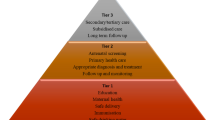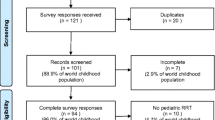Abstract
Background
In 1998, a survey of the European Society for Paediatric Nephrology (ESPN) revealed substantial disparities in pediatric renal care among European countries. Therefore, ESPN aimed at harmonizing renal care in all European countries in the following 20 years. In 2017, we conducted a survey to evaluate the current status of renal health policies for children in Europe.
Methods
A 33-question web-based survey was designed and sent to presidents or representatives of national societies of pediatric nephrology in 44 European countries.
Results
Data was reported from 42 (95.5%) countries. The number of pediatric nephrologists per million child population increased from 1998 to 2017 in 70% of countries. Pediatric dialysis facilities for acute kidney injury and end-stage kidney disease were available in 95% of countries. The availability of pediatric kidney transplantation increased from 55 to 93% of countries. Considerable variation was found in the current availability of allied health professionals, including psychosocial and nutritional support, high-tech diagnostic methods, and treatment with expensive drugs for children with kidney diseases between different European countries.
Conclusions
The 20-year follow-up analysis of pediatric renal care services in European countries revealed that pediatric nephrology has become a well-established subspecialty in pediatrics and nephrology in 2017. The ESPN will continue its efforts to further improve pediatric renal care for European children by harmonizing remaining disparities of renal care services.

Similar content being viewed by others
References
Zipursky A (2002) A history of pediatric specialties. Pediatr Res 52:617. https://doi.org/10.1203/00006450-200211000-00002
Tse Y, Maxwell H, Watson AR, Coward R, Levtchenko E, Christian M, European society for paediatric nephrology (2018) preserving oral history: 50 years of paediatric nephrology in Europe. Arch Dis Child 103:1010–1012. https://doi.org/10.1136/archdischild-2018-315308
Ehrich JHH, Gendi AA, Drukker A, Janda J, Stefanidis C, Verrier-Jones K, Collier J, Katz M (2005) Demography of paediatric renal care in Europe: organization and delivery. Nephrol Dial Transplant 20:297–305 https://doi.org/10.1093/ndt/gfh299
The World Bank database (2017). https://datahelpdesk.worldbank.org/knowledgebase/articles/906519. Accessed 24 August 2019
Kramer A, Stel VS, Caskey FJ, Stengel B, Elliott RF, Covic A, Geue C, Cusumano A, Macleod AM, Jager KJ (2012) Exploring the association between macroeconomic indicators and dialysis mortality. Clin J Am Soc Nephrol 7:1655–1663. https://doi.org/10.2215/CJN.10461011
US Bureau of the Census (2017). https://www.indexmundi.com. Accessed 24 August 2019
Ehrich J, Kerbl R, Pettoello-Mantovani M, Lenton S (2015) Opening the debate on pediatric subspecialties and specialist centers: opportunities for better care or risks of care fragmentation. J Pediatr 167:71–74. https://doi.org/10.1016/j.jpeds.2015.07.060
ESPN. www.espn-online.org. Accessed 24 August 2019
ESPN / ERA-EDTA Registry for children on renal replacement therapy. https://www.espn-reg.org. Accessed 24 August 2019
Glenn D, Ocegueda S, Nazareth M, Zhong Y, Weinstein A, Primack W, Cochat P, Ferris M (2016) The global pediatric nephrology workforce: a survey of the International Pediatric Nephrology Association. BMC Nephrol 17:1–11. https://doi.org/10.1186/s12882-016-0299-2
Primack WA, Glenn DA, Meyers KEC (2016) Pediatric nephrology training worldwide 2016: Quantum Educatus? Kidney Int Rep 18:144–147. https://doi.org/10.1016/j.ekir.2016.07.002
Paediatric Section of the Union of European Medical Specialists (2018). https://espn-online.org/training_doc.pdf. Accessed 24 August 2019
Phadke K, Bagga A (2005) Training in pediatric nephrology for developing countries. Pediatr Nephrol 20:1205–1207. https://doi.org/10.1007/s00467-005-1972-z
Sharif MU, Elsayed ME, Stack AG (2016) The global nephrology workforce: emerging threats and potential solutions! Clin Kidney J 9:11–22. https://doi.org/10.1093/ckj/sfv111
International Pediatric Nephrology Association IPNA Online/Fellowship Program. https://www.ipna-online.org/education/fellowship-program. Accessed 24 August 2019
IPNA-ESPN Master for Junior Classes. https://espn-online.org/2_ipna_espn.php. Accessed 24 August 2019
European Reference Kidney Network. https://www.erknet.org. Accessed 24 August 2019
Acknowledgments
The authors would like to thank the representatives from European national pediatric nephrology societies who answered the survey and provided the data reported in this paper. We thank all ESPN council members in 2017 for their input and support: Ariceta G. (Spain), Bacchetta J. (France), Duzova A. (Turkey), Haffner D. (Germany).
European Society for Paediatric Nephrology collaborators (in alphabetical order) Anton-Gamero M. (Spain), Arikoski P. (Finland), Aufricht C. (Austria), Awan A. (Ireland), Bakkaloglu SA (Turkey), Baylarov R. (Azerbaijan), Bjerre A. (Norway), Brandström P. (Sweden), Chafai R. (Luxembourg), Lotan D. (Israel), Davitaia T. (Georgia), Dlin V. (Russia), Golubovic E. (Serbia), Hadjipanayis A. (Cyprus), Hoyer P. (Germany), Hughes DA (UK), Ivanov D. (Ukraine), Jankauskiene A. (Lithuania), Kamperis K. (Denmark), Kersnik Levart T. (Slovenia), Laube G. (Switzerland), Lungu A. (Romania), Milosevic D. (Croatia), Murer L. (Italy), Nigmatullina N. (Kazakhstan), Podraska L. (Slovak Republic), Pokrajac D. (Bosnia and Herzegovina), Reusz G.S. (Hungary), Roussey G. (France), Roussinov D. (Bulgaria), Said Conti V. (Malta), Sarkissian A. (Armenia), Schreuder M. (The Netherlands), Seeman T. (Czech Republic), Shtiza D. (Albania), Simão C. (Portugal), Stefanidis C.J. (Greece), Tasic V. (Macedonia), Toots Ü. (Estonia), Tur N. (Belarus), Walle JV (Belgium), Zurowska A. (Poland).
Author information
Authors and Affiliations
Consortia
Contributions
All authors participated to the designing of the questionnaire. LP, JE, and EL checked the data, analyzed the results, and drafted the manuscript with the help of all other authors, who revised it critically. All authors reviewed and approved the final version of the manuscript.
Corresponding author
Ethics declarations
Conflict of interest
The authors declare that they have no conflict of interest.
Additional information
Publisher’s note
Springer Nature remains neutral with regard to jurisdictional claims in published maps and institutional affiliations.
Rights and permissions
About this article
Cite this article
Prikhodina, L., Ehrich, J., Shroff, R. et al. The European Society for Paediatric Nephrology study of pediatric renal care in Europe: comparative analysis 1998–2017. Pediatr Nephrol 35, 103–111 (2020). https://doi.org/10.1007/s00467-019-04378-5
Received:
Revised:
Accepted:
Published:
Issue Date:
DOI: https://doi.org/10.1007/s00467-019-04378-5




